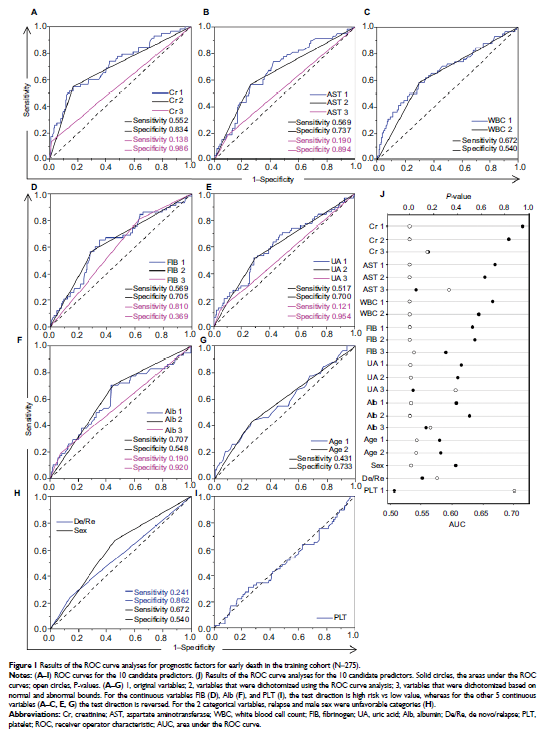108605
论文已发表
注册即可获取德孚的最新动态
IF 收录期刊
- 3.4 Breast Cancer (Dove Med Press)
- 3.2 Clin Epidemiol
- 2.6 Cancer Manag Res
- 2.9 Infect Drug Resist
- 3.7 Clin Interv Aging
- 5.1 Drug Des Dev Ther
- 3.1 Int J Chronic Obstr
- 6.6 Int J Nanomed
- 2.6 Int J Women's Health
- 2.9 Neuropsych Dis Treat
- 2.8 OncoTargets Ther
- 2.0 Patient Prefer Adher
- 2.2 Ther Clin Risk Manag
- 2.5 J Pain Res
- 3.0 Diabet Metab Synd Ob
- 3.2 Psychol Res Behav Ma
- 3.4 Nat Sci Sleep
- 1.8 Pharmgenomics Pers Med
- 2.0 Risk Manag Healthc Policy
- 4.1 J Inflamm Res
- 2.0 Int J Gen Med
- 3.4 J Hepatocell Carcinoma
- 3.0 J Asthma Allergy
- 2.2 Clin Cosmet Investig Dermatol
- 2.4 J Multidiscip Healthc

建立一个风险评级系统,以识别过早死亡风险较高的急性早幼粒细胞白血病患者
Authors Zhang Y, Hou W, Wang P, Hou J, Yang H, Zhao H, Jin B, Sun J, Cao F, Zhao Y, Li H, Ge F, Fu J, Zhou J
Received 12 March 2018
Accepted for publication 16 July 2018
Published 17 September 2018 Volume 2018:10 Pages 3619—3627
DOI https://doi.org/10.2147/CMAR.S167686
Checked for plagiarism Yes
Review by Single-blind
Peer reviewers approved by Dr Amy Norman
Peer reviewer comments 5
Editor who approved publication: Professor Kenan Onel
Background: Early death (ED) rate in acute promyelocytic leukemia (APL)
remains high. Some studies have identified prognostic factors capable of
predicting ED, whereas no risk rating system for ED has been reported in the
literature. In this study, a risk classification system was built to identify
subgroup at high risk of ED among patients with APL.
Methods: Totally, 364 consecutive APL patients who received arsenic
trioxide as induction therapy were included. Ten baseline clinical
characteristics were selected for analysis, and they were de novo/relapse, age,
sex, white blood cell count, platelet count, serum fibrinogen, creatinine, uric
acid, aspartate aminotransferase, and albumin. Using a training cohort (N=275),
a multivariable logistic regression model was constructed, which was internally
validated by the bootstrap method and externally validated using an independent
cohort (N=89). Based on the model, a risk classification system was designed.
Then, all patients were regrouped into de novo (N=285) and relapse (N=79)
cohorts and the model and risk classification system were applied to both
cohorts.
Results: The constructed model included 8 variables without platelet count
and sex. The model had excellent discriminatory ability (optimism-corrected
area under the receiver operator characteristic curve=0.816±0.028 in the
training cohort and area under the receiver operator characteristic curve=0.798
in the independent cohort) and fit well for both the training and independent
data sets (Hosmer–Lemeshow test, P =0.718 and 0.25,
respectively). The optimism-corrected calibration slope was 0.817±0.12. The
risk classification system could identify a subgroup comprising ~25% of
patients at high risk of ED in both the training and independent cohorts
(OR=0.140, P <0.001 and OR=0.224, P =0.027, respectively). The risk
classification system could effectively identify patient subgroups at high risk
of ED in not only de novo but also relapse cohorts (OR=0.233, P <0.001 and OR=0.105, P =0.001, respectively).
Conclusion: All the results highlight the high practical value of the risk
classification system.
Keywords: acute promyelocytic leukemia, early death, risk classification
system, relapse, arsenic trioxide
